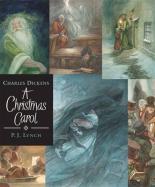LoveReading4Kids Says
“Bah!” “Humbug!” Ebenezer Scrooge hates Christmas and he does his best to stop others enjoying it either. But then he gets a visit from three ghostly visitors – the ghosts of Christmases Past, Present and Yet to Come. The three ghosts reveal some truths to the mean old Scrooge which make him change his mind forever. P.J. Lynch’s atmospheric illustrations capture the dark and cold world of Scrooge’s meanness and juxtapose them with the jollity that is traditionally associated with Christmas.
LoveReading4Kids
Find This Book In
A Christmas Carol, Illustrated Edition Synopsis
First published in 1843, this lavish, unabridged new edition resonates with the true spirit of Christmas. It is superbly illustrated by P. J. Lynch whose detailed, atmospheric artwork brings Dickensian London vividly alive.
About This Edition
| ISBN: |
9781406305791 |
| Publication date: |
7th September 2009 |
| Author: |
Charles Dickens |
| Publisher: |
Walker Books Ltd |
| Format: |
Paperback |
| Suitable For: |
|
About Charles Dickens
Charles Dickens was an English writer and social critic who is generally regarded as the greatest novelist of the Victorian period and the creator of some of the world's most memorable fictional characters. During his lifetime Dickens's works enjoyed unprecedented popularity and fame, and by the twentieth century his literary genius was fully recognized by critics and scholars. His novels and short stories continue to enjoy an enduring popularity among the general reading public.
Throughout 2012 there are numerous Dickens Events mark the bicentenary of his birth - www.dickens2012.org .
He was born Charles John Huffam Dickens on 7th February 1812, in Portsmouth, to John, a clerk at the Naval Pay Office, and Elizabeth Dickens. The good fortune of being sent to school at the age of nine was short-lived because his father, inspiration for the character of Mr Micawber in David Copperfield, was imprisoned for bad debt in the Marshalsea in 1824.
12 year old Charles was sent to work in Warren's boot-blacking factory, in Hungerford Market near The Strand, London. Earning six shillings a week to help support the family, he endured appalling conditions as well as loneliness and despair. After three years he was returned to school, but the experience was never forgotten and became fictionalised in two of his better-known novels David Copperfield and Great Expectations.
This childhood poverty and feelings of abandonment, although unknown to his readers until after his death, would be a heavy influence on Dickens' later views on social reform and the world he would create through his fiction.
Like many others, he began his literary career as a journalist. His own father became a reporter and Charles began with the journals 'The Mirror of Parliament' and 'The True Sun'. Then in 1833 he became parliamentary journalist for The Morning Chronicle. With new contacts in the press he was able to publish a series of sketches under the pseudonym 'Boz'.
In April 1836, he married Catherine Hogarth, daughter of George Hogarth who edited Sketches by Boz. Within the same month came the publication of the highly successful Pickwick Papers, and from that point on there was no looking back for Dickens.
Dickens would go on to write 15 major novels and countelss short stories and also a published autobiography. He edited weekly periodicals including 'Household Words' and 'All Year Round', wrote travel books and administered charitable organisations.
He was also a theatre enthusiast, wrote plays and performed before Queen Victoria in 1851. His energy was inexhaustible and he spent much time abroad - for example lecturing against slavery in the United States and touring Italy with companions Augustus Egg and Wilkie Collins, a contemporary writer who inspired Dickens' final unfinished novel The Mystery of Edwin Drood.
He was estranged from his wife in 1858 after the birth of their ten children..
He died of a stroke on 9th June 1870. He wished to be buried, without fanfare, in a small cemetery in Rochester, but the Nation would not allow it. He was laid to rest in Poet's Corner, Westminster Abbey, the flowers from thousands of mourners overflowing the open grave. Among the more beautiful bouquets were many simple clusters of wildflowers, wrapped in rags.
The Charles Dickens Museum can be found at 48 Doughty Street, London. Two of his daughters were born here, his sister-in-law Mary died aged 17 in an upstairs bedroom and some of Dickens’s best-loved novels were written here, including Oliver Twist and Nicholas Nickleby.
Major Works of Charles Dickens
Sketches by Boz (1836)
Pickwick Papers (serialized monthly 1836-37)
Oliver Twist (serialized monthly 1837-39)
Nicholas Nickleby (serialized monthly 1838-39)
The Old Curiosity Shop (serialized weekly 1840-41)
Barnaby Rudge (serialized weekly 1841)
Martin Chuzzlewit (serialized monthly 1843-44)
Dombey and Son (serialized monthly 1846-48)
David Copperfield (serialized monthly 1849-50)
Bleak House (serialized monthly 1852-53)
Hard Times (serialized weekly 1854)
Little Dorrit (serialized monthly 1855-57)
A Tale of Two Cities (serialized weekly 1859)
Great Expectations (serialized weekly 1860-61)
Our Mutual Friend (serialized monthly 1864-65)
The Mystery of Edwin Drood - unfinished (serialized monthly 1870)
More About Charles Dickens
